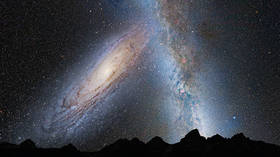LIVESTREAMING the skies: Ursids meteor shower caught on camera as celestial spectacle set to peak
Meteors falling from the skies have been captured on a livestream, for those wishing to stargaze without leaving the comfort of their homes. But there's still time to see the Ursids meteor shower with your own eyes.
A livestream set up by the American Meteor Society documented Saturday’s meteor activity. The footage shows the dark night sky pepped with stars – and of course, an occasional meteor. Stargazers need to be patient – typically there’s only 5-10 meteors per hour.
Named after the constellations Ursa Major and Ursa Minor, the Ursids are best viewed from the Northern Hemisphere. The shower is thought to be produced by debris from Comet 8P/Tuttle, discovered in 1858.
The meteors are incredibly small – usually no bigger than a pebble – but they reach speeds of up to 50,000mph, creating a bright light when they hit the Earth’s atmosphere.
It’s not too late to see the celestial fireworks, assuming you’re in the correct hemisphere and have a clear view of the night sky: the shower is set to peak on the evening of December 22 and into the predawn hours of December 23.
Like this story? Share it with a friend!














